|

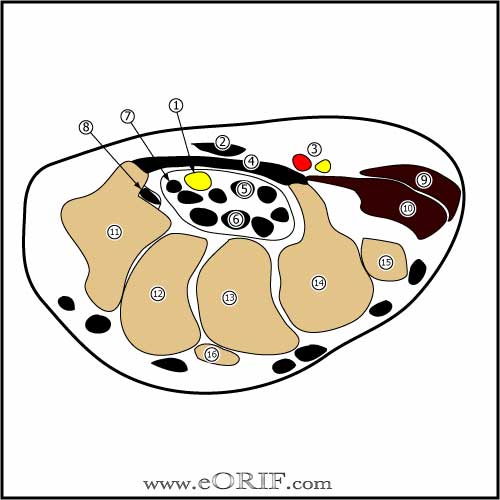
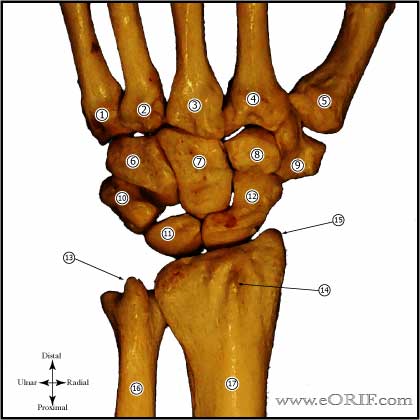
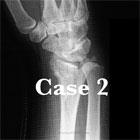

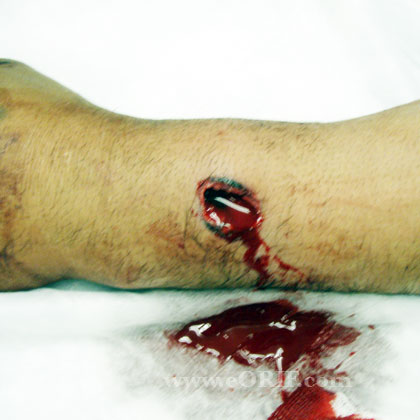
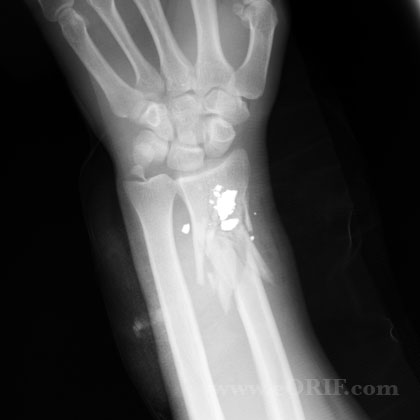
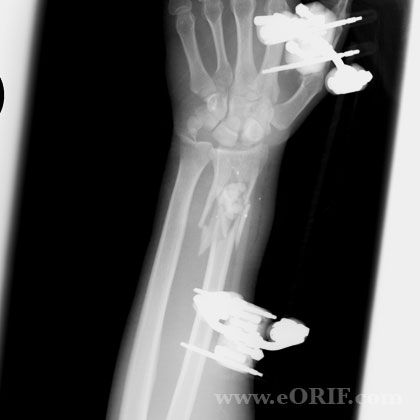
|
synonyms: Colles fracture, distal radius fracture, wrist fracture
Distal Radius Fracture ICD-10
Distal Radius Fracture ICD-9
- 813.40(closed lower end of forearm unspecified), 813.50(open lower end unspecified)
- 813.41(closed Colles Fx), 813.51(open Colles Fx
- 813.42(closed other fractures of distal end of radius alone) (813.52(open other radius alone)
- 813.44 (closed radius with ulna fracture; lower end)
Distal Radius Fracture Etiology / Epidemiology / Natural History
- Most common fx of UE. 17% of fx/yr.
- Most commonly women age 60-70.
- 90% caused by compression on dorsiflexed wrist.
- 90% of distal radius fractures are Colles Fractures
Distal Radius Fracture Anatomy
- Distal radius carries 80% of axial load
- ROM-80°dorsiflexion, 85°palmarflexion, 90°pro\sup,25°radial deviation,35°ulnar deviation
- Distal radius 3 column anatomy: Radial column (strong cortical bone), Intermediate column (contains lunate facet and sigmoid notch); Distal ulna column (contains TFCC) (Rikle DA, JBJS 1996;78Br:588)
- Radial inclination=23°,radial length=12mm, volar tilt=11°, ulnar variance -0.6mm, scapholunate angle = 60° +/-15°. (Medoff RJ, Hand Clin 2005;21:279)
- Sensory branch of radial nerve becomes subcutaneous 5-10cm proximal to radial styloid in interval between brachioradialis and ECRL. It bifurcates before wrist. Dorsal branch 1-3cm radial to Listers. Supplies 1st and 2nd web spaces. Palmar branch passes within 2cm of 1st dorsal compartment provides sensation to dorsolateral thumb after passing directly over EPL.
- Palmar cutaneous branch of the Median nerve arises from the Median nerve @4-6cm proximal to the volar wrist crease and travels between the FCR and median nerve. Supplies sensation to the thenar area.
- Dorsal cutaneous branch of ulnar n arises deep to FCU, becomes SQ 5cm from pisiform-has multiple branches
Distal Radius Fracture Clinical Evaluation
- Pain and swelling in wrist generally after a fall onto the outstretched hand. Often gross deformity in wrist.
- Document neurovascular exam
- Evaluated for carpal tunnel syndrome
Distal Radius Fracture Xray
- PA, Lateral wrist films. Normal radiographic parameters: Radial inclination=23°,radial length=12mm, volar tilt=11°, scapholunate angle = 60° +/-15°. Assess ulnar variance, carpal alignment and sigmoid notch conguence. A/P widening on the lateral radiograph indicates articular surface displacement.
- Radial length: best measured on true PA radiographs of both wrists for comparision. Draw a line perpendicular to the long axis of the radius intersecting the distal articular surface of the ulnar head. And measure the distance to the tip of the radial styloid. Normal length is 10-13mm
- Signs of DRUJ injury: fracture at the base of the ulnar styloid, widening of the DRUJ space seen on the P/A xray, >20° of dorsal radial angulation, and >5 mm of proximal displacement of the distal part of the radius. (Szabo RM, JBJS 2006;88Am:884)
- 1mm-2mm sagital CT best to view articular depression fx
- MRI if TFCC or scapholunate ligment tears suspected
- CT (3-dimensional) improves recongnition of articular comminution and may aid in pre-operative planning (Harness NG, JBJS 2006;88A:1315).
- Teardrop of the distal radius: volar ulnar corner of the distal radius. Malreduction of the volar ulnar corner leads to volar subluxation of the lunate and the development of posttraumatic arthritis. (Medoff RJ. Essential radiographic evaluation for distal radius fractures. Hand Clin. 2005 Aug;21(3):279-88. Review.)
Distal Radius Acceptable Reduction
- <2mm articular stepoff
- <5mm shortening
- <10° dorsal tilt
- Surgical indications: radial shortening >3mm, dorsal tilt >10º, intra-articular displacement or step-off >2mm. (AAOS Clinical Practice Guideline, 2011)
Distal RadiusFractureFx Classification/Treatment
- Non-Geriatric Patients (< 65): operative treatment indicated for fractures with post reduction radial shortening >3mm, dorsal tilt >10 degrees, or intraarticular displacement or step off >2 mm leads to improved radiographic and patient reported outcomes. (AAOS CPG 2021)
- Geriatric Patients (>65); operative treatment does not lead to improved long-term patient reported outcomes. (AAOS CPG 2021)
- AAOS Appropriate Use Criteria (AUC) on the Treatment of Distal Radius Fractures
- AO Classification
- AO Type A=extra-articular
- AO Type B=partial articular; fx of radial styloid, medial corner, die-punch fracture of central articular surface
- AO Type C=complex articular; high-energy, none of the articular surface remains in continuity with the metaphysic. Involvement of >50% of the diameter of the metaphysic as seen on any radiograph, comminution of at least 2 corticies of the metaphysic, or >2.0mm of shortening of the radius.
- Treatment Options:
-Closed reduction with well molded cast/splint
-Distal Radius External Fixation 20690
-Distal Radius ORIF 25607
-Spanning internal fixation: high-energy fx’s with proximal extension of at least 4cm may be treated with distraction 3.5mm ASIF Synthes plate similar to wrist fusion with screws in 3rd metacarpal and proximal radial shaft. 12-16 hole 3.5mm plate is needed +/- bone graft. (Ruch DS, JBJS 2005;87A:945)
- Radial Styoid fracture: can be approached via the first dorsal extensor compartment, identify radial nerve, Dissection and plate application procedes between the dorsal and palmar branches. Brachioradialis is elevated and later closed over the plate.
- Consider Osteoporosis evaluation and management.
- Colles' Fracture = dorsally displaced fracture of the distal radius generally occuring 2-3 cm proximal to the radiocarpal joint. 90% of distal radius fractures.
- Barton's Fracture = a fracture-dislocation of the radiocarpal joint in which the carpus displaces with either a volar (volar Barton's fracture) or dorsal fragment (dorsal Barton's fracture) of the distal radius. Volar Barton's fracture are more common. Treatment = ORIF or closed reduction, external fixation and percutaneous pinning.
- Smith's Fracture = reverse Colles' fracture; may be caused by backwards fall resulting in forced wrist pronation.
- Chauffeur's fracture = intraarticular fracture of the base of the radial styloid. Used to occur then cars backfired while they were being crank started.
- Wrist Arthroscopy / Arthroscopic Assistance: Inconsistent evidence suggests no benefit for arthroscopic assistance in distal radius fractures. (AAOS CPG, 20221)
Distal Radius Fracture Associated Injuries / Differential Diagnosis
- Scapholunate ligament tear: 21.5% with intraarticular fracture, 6.7% with extraarticular fracture (Richards RS, J Hand Surg 1997;22Am:772).
- Median nerve injury
- TFCC injury, up to 50% when ulnar styloid fx also present
- Carpal ligment injury:Scapholunate Instability(most common), lunotriquetral ligament
- Tendon injury,attritional EPL rupture, usually treated with EIP tendon transfer
- Compartment syndrome@1%
- Ulnar styloid fracture
- DRUJ Instability
- Galeazzi Fracture: highly associated with distal 1/3 radial shaft fractures
Distal Radius Fracture Complications
- Malunion = typically loss of radial height, ulnar and volar inclination less commonly inarticular incongruity.
- Nonunion: uncommon except with volar and dorsal plating with extensive sub-periosteal stripping.
- Distal radioulnar joint injury
- Contracture
- Neurologic injury
- Complex regional pain syndrome(CRPS) (2-20%)
- Hardware failure
- Painful Hardware
- Risks of surgery including but not limited to: malunion, nonunion, stiffness, CRPS, nerve or vascular injury, painful hardware, loss of fixation, tendon injury, infection, arthritis, incomplete relief of pain, incomplete return of function and the risks of anesthesia including heart attack, stroke, and death.
Distal Radius Fracture Follow up care
- Post-Op: Place in volar splint. Encourage active digital ROM, elevation. Consider adjuvant Vitamin C for prevention of CRPS.
- 7-10 Days: remove splint. Place in short arm cast. Consider removable splint with gentle ROM if fixation was extremely secure.
- 6 Weeks: Cast removed. Check xrays. Started gentle ROM exercises. Activity modifications: no heavy manual labor, no contact sports, no lifting >5 lbs.
- 3 Months: Check xrays. If union is complete return to full activities.
- Standard Technique to measure ulnar inclination, palmar tilt, ulnar variance and articular congruity = Kreder HJ, J Hand Surg 1996;21A:532
- Patients may have incomplete return of motion, DRUJ pain and deformity, wrist pain and loss of grip strength. Some permanent disability is not uncommon.
- At >10 year follow up patients (age 18-65) with malunion have significantly worse outcomes including activity limitations and pain. There is no significant outcome difference for those that develop arthritis or styloid nonunion. (Ali, M; JBJA 1028:100;633)
Distal Radius Fracture References
|








